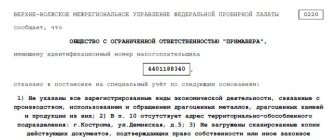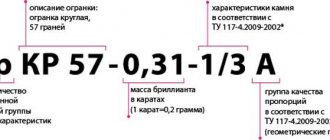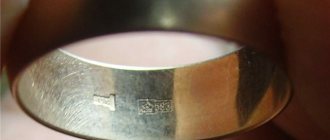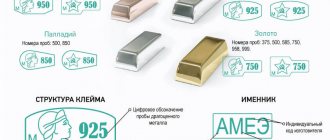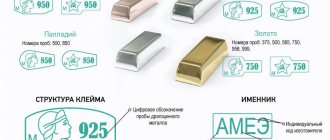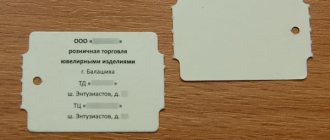| Federal Assay Chamber (FPP) | |
| Decree “On the formation of ... chambers” | |
| general information | |
| date of creation | October 28, 2021 |
| Predecessor agency | Federal State Institution "Russian State Assay Office under the Ministry of Finance of the Russian Federation" |
| Website | |
| https://probpalata.ru/ | |
The Federal Assay Chamber (FPP)
is a federal service subordinate to the Ministry of Justice of the Russian Federation, established by the Decree of the President of the Russian Federation on the formation of the Federal Assay Chamber on October 28, 2019.
Before the establishment of the FPP, it was part of the Ministry of Justice of the Russian Federation as a federal government institution “Russian State Assay Office under the Ministry of Finance of the Russian Federation”.
In accordance with the Decree, the FPP is entrusted with the functions of state control (supervision) over the production, use and circulation of precious metals, the use and circulation of precious stones (with the exception of functions of control when importing into the Russian Federation from states not members of the Eurasian Economic Union, and export of precious stones from the Russian Federation to states not members of the Eurasian Economic Union)[1].
[edit] From the history of the Assay Supervision of Russia
Assay supervision has existed in Russia since the 17th century, although primitive testing of gold and silver by fire was known in Rus' even before Peter I - it was used by merchants and gold and silversmiths. The first Russian (Moscow) mark - a double-headed eagle, accompanied by a date expressed in Slavic letters, dates back to 1651-1652.
In 1700, after the “coinage reform” of Peter I, during the formation of the Russian national market, a decree was issued “On the establishment of hallmarks for testing gold and silver items, on the correspondence of gold and silver rows and shops, on the selection of elders to supervise trade and artisans for branding gold and silver items with the collection of a fee.” Four gold and four silver samples were introduced: “At the beginning, make four gold tests: the first above the gold standard, the second against the gold, the third and fourth gold samples below the gold and set the price of what those gold samples can cost. Also, make four silver hallmarks, two fused silver ones, a higher and a lower one, a third ephimochnaya, a fourth levkovaya hallmark, and make hallmarks according to the hallmarks with annual letters.” This decree is considered the beginning of the hallmarking of products made of precious metals[2].
Documents Statistics on documents and execution of orders
GOVERNMENT OF THE RUSSIAN FEDERATION
RESOLUTION
dated June 25, 2021 No. 1015
MOSCOW
About the federal state assay supervision
(As amended by Decree of the Government of the Russian Federation dated 09/03/2021 No. 1488)
In accordance with paragraph 1 of part 2 of article 3 of the Federal Law “On State Control (Supervision) and Municipal Control in the Russian Federation” and Article 261 of the Federal Law “On Precious Metals and Precious Stones”, the Government of the Russian Federation decides:
1. Approve the attached:
Regulations on federal state assay supervision;
a list of production facilities of refining organizations and organizations carrying out sorting, primary classification and primary assessment of precious stones, in respect of which a regime of constant state control (supervision) is established.
2. Recognize as invalid the acts of the Government of the Russian Federation according to the list according to the appendix.
3. The implementation of the powers provided for by this resolution is carried out by the Federal Assay Chamber (its territorial bodies) within the limits established by the Government of the Russian Federation of the maximum number of employees of the Federal Assay Chamber (its territorial bodies), as well as budgetary allocations provided for by the Federal Assay Chamber (its territorial bodies) in the federal budget for leadership and management in the field of established functions.
4. This resolution comes into force on July 1, 2021.
Chairman of the Government of the Russian Federation M. Mishustin
APPROVED by Decree of the Government of the Russian Federation dated June 25, 2021 No. 1015
REGULATIONS on Federal State Assay Supervision
I. General provisions
1. These Regulations establish the procedure for the implementation of federal state assay supervision.
2. Federal state assay supervision is carried out by the federal executive body exercising the functions of state control (supervision) in the field of production, use and circulation of precious metals and precious stones.
Permanent state control (supervision) in relation to organizations engaged in sorting, primary classification and primary evaluation of precious stones is carried out by a state institution that carries out functions in the field of use and circulation of precious stones, subordinate to the authorized federal executive body that carries out the functions of developing state policy and normative -legal regulation in the field of production, processing and circulation of precious metals and precious stones.
3. The subject of federal state assay supervision is compliance with:
legal entities, individual entrepreneurs engaged in the production, use, circulation of precious metals in any condition and form, sorting, primary classification and initial assessment of precious stones, their use and circulation, established by the Federal Law “On Precious Metals and Precious Stones”, other federal laws and other regulatory legal acts of the Russian Federation, mandatory requirements in the field of production, use and circulation of precious metals, as well as mining (in terms of sorting, primary classification and initial evaluation of precious stones), use and circulation of precious stones;
organizations and individual entrepreneurs (licensees) engaged in processing (processing) scrap and waste of precious metals and (or) activities for purchasing jewelry and other products made of precious metals and precious stones from individuals, scrap of such products, licensing requirements for these types activities established by the Regulations on licensing activities for the processing (processing) of scrap and waste of precious metals (with the exception of activities for the processing (processing) by organizations and individual entrepreneurs of scrap and waste of precious metals generated and collected by them in the process of their own production, as well as jewelry and other products made of precious metals of own production, unsold and returned to the manufacturer) and the Regulations on licensing activities for the purchase from individuals of jewelry and other products made of precious metals and precious stones, scrap of such products, approved by Decree of the Government of the Russian Federation of September 12, 2020 No. 1418 “On licensing of certain types of activities related to precious metals and precious stones.”
4. Accounting for objects of federal state assay supervision - the activities of legal entities and individual entrepreneurs operating in the field of extraction, production, use and circulation of precious metals and precious stones (hereinafter - objects of supervision, controlled entities) is carried out by including in the register of special registration of legal entities persons and individual entrepreneurs carrying out transactions with precious metals and precious stones.
When implementing federal state assay supervision, a regime of constant state control (supervision) is established in relation to refining organizations and organizations carrying out sorting, primary classification and initial assessment of precious stones, in accordance with the provisions of the Federal Law “On State Control (Supervision) and Municipal Control in the Russian Federation Federation" (hereinafter referred to as Federal Law No. 248-FZ).
5. Federal state assay supervision is carried out by the Federal Assay Chamber in accordance with Section II of these Regulations.
Permanent state control (supervision) in relation to organizations engaged in sorting, primary classification and primary evaluation of precious stones is carried out by the federal government institution “State Institution for the Formation of the State Fund of Precious Metals and Precious Stones of the Russian Federation, Storage, Release and Use of Precious Metals and Precious Stones (Gokhran of Russia) under the Ministry of Finance of the Russian Federation" (hereinafter - Gokhran of Russia) in accordance with Section III of these Regulations.
6. Federal state assay supervision is carried out, inter alia, using the state integrated information system in the field of control over the circulation of precious metals, precious stones and products made from them at all stages of this circulation (hereinafter referred to as GIIS DMDK).
II. The procedure for the implementation of federal state assay supervision by the Federal Assay Chamber
7. The Federal Assay Chamber carries out federal state assay supervision using criteria for classifying objects of supervision into categories of risk of harm (damage) (hereinafter referred to as the criteria).
In order to implement federal state assay supervision, the following risk categories are established:
extremely high risk;
high risk;
medium risk;
low risk.
8. The classification of objects of supervision as risk categories is given in Appendix No. 1.
If there is information about the implementation by a controlled person classified as high or medium risk of measures to exclude the application of risk criteria corresponding to the categories of high or medium risk to the activities of such persons, the activities of such person shall be classified as low risk.
When a controlled person provides access to the Federal Assay Chamber to its information resources, the activities of such a person are subject to classification as low risk.
If the object of supervision is not classified by the control (supervisory) body into a certain risk category, it is considered to be classified as low risk.
9. The assignment of objects of supervision to a certain risk category, including changes in the risk category previously assigned to an object of supervision, is carried out on the basis of data available to the Federal Assay Office, as well as using the GIIS DMDK and is approved by the appropriate decision of the authorized official of the territorial body of the Federal Assay Office chamber in agreement with an official of the Federal Assay Chamber (hereinafter referred to as the decision on classification as a risk).
If a controlled person carries out activities in the field of production, use and circulation of precious metals and precious stones in the areas of activity of several territorial bodies of the Federal Assay Chamber, the assignment of objects of supervision to a certain risk category, including changing the risk category previously assigned to the object of supervision, is carried out by the appropriate by a decision of the authorized official of the territorial body of the Federal Assay Chamber at the place of state registration of the controlled person in agreement with the official of the Federal Assay Chamber.
10. Before a decision is made to assign it to one of the risk categories, the object of supervision is considered to be classified as low risk.
11. The implementation of planned control measures in relation to controlled persons, depending on the assigned risk category, by authorized officials of the territorial bodies of the Federal Assay Chamber is carried out with the following frequency:
for an extremely high-risk category, an inspection visit, or a documentary inspection, or an on-site inspection, or an on-site inspection - 2 times a year;
for a high-risk category, an inspection visit, or a documentary inspection, or an on-site inspection, or an on-site inspection - once every 2 years;
for the medium-risk category, an inspection visit, or a documentary check, or an on-site check, or an on-site inspection - once every 3 years.
In relation to the activities of controlled persons, which are classified as low risk, no planned control measures are carried out.
12. The territorial bodies of the Federal Assay Chamber maintain a list of controlled persons, which contains the following information:
full name of the legal entity, last name, first name and patronymic (if any) of the individual entrepreneur;
special account number;
main state registration number of a legal entity, individual entrepreneur;
taxpayer identification number;
location of a legal entity, individual entrepreneur;
an indication of the risk category of the controlled person’s activities, the date of the decision to classify the controlled person’s activities as a risk category.
13. The Federal Assay Chamber publishes on its official website on the information and telecommunications network “Internet” (hereinafter referred to as the “Internet”) and maintains up to date the following information from the list of controlled persons with their distribution by areas of activity of the territorial bodies of the Federal Assay Chamber:
full name of the legal entity, last name, first name and patronymic (if any) of the individual entrepreneur;
special account number;
main state registration number of a legal entity, individual entrepreneur;
taxpayer identification number;
location of a legal entity, individual entrepreneur;
an indication of the risk category of the controlled person’s activities, the date of the decision to assign the controlled person to the risk category.
14. At the request of a controlled person whose activity has been assigned a certain risk category, the territorial body of the Federal Assay Chamber provides the controlled person with information about the risk category assigned to his activity, as well as information on the basis of which the decision to assign him to the risk category was made.
15. A controlled person has the right to submit an application to the territorial body of the Federal Assay Chamber to change the previously assigned risk category if the criteria for classifying objects of supervision to a certain risk category change.
16. The Federal Assay Chamber annually approves a program for the prevention of violations of the mandatory requirements of the Federal Law “On Precious Metals and Precious Stones” (hereinafter referred to as the program for the prevention of violations of mandatory requirements) in the field of federal state assay supervision, which is posted on the official website of the Federal Assay Chamber on the Internet "
17. When approving a program for the prevention of violations of mandatory requirements, the Federal Assay Office takes into account the risk categories to which the activities of controlled persons are classified.
The Federal Assay Office can carry out the following preventive measures:
informing;
generalization of law enforcement practice;
announcement of warning;
preventive visit;
consulting.
18. The Federal Assay Chamber informs controlled persons and other interested parties on issues of compliance with mandatory requirements by posting relevant information on the official website of the Federal Assay Chamber on the Internet, in the media, through personal accounts of controlled persons in state information systems.
The Federal Assay Office publishes and keeps up to date on its official website on the Internet:
texts of regulatory legal acts regulating the implementation of federal state assay supervision;
a list of regulatory legal acts regulating the implementation of federal state assay supervision, indicating the structural units of these acts containing mandatory requirements, assessment of compliance with which is the subject of control, as well as information on the penalties applied in case of violation of mandatory requirements;
information on changes made to the regulatory legal acts regulating the implementation of federal state assay supervision, on the timing and procedure for their entry into force;
guidelines for compliance with mandatory requirements developed and approved in accordance with the Federal Law “On Mandatory Requirements in the Russian Federation”;
a list of criteria and indicators of the risk of violation of mandatory requirements, the procedure for classifying the activities of controlled persons into risk categories;
list of controlled persons indicating the risk category;
a program for the prevention of violations of mandatory requirements and a plan for carrying out planned control (supervisory) activities by territorial bodies;
an exhaustive list of information that may be requested by the territorial body of the Federal Assay Office from a controlled person;
information on ways to obtain advice on compliance with mandatory requirements in the field of federal state assay supervision;
quarterly information on the procedure for pre-trial appeal of decisions of the territorial body of the Federal Assay Chamber, which carries out federal state assay supervision, actions (inaction) of its officials no later than the 10th day of the month following the reporting month;
a report prepared by the body exercising federal state assay supervision at least once a year;
public discussion of the draft report on law enforcement practice;
an annual report, including the results of a generalization of law enforcement practice on the state of the federal state assay supervision, which is approved by order (instruction) of the head of the Federal Assay Chamber, no later than March 1 of the year following the reporting year;
other information provided for by the regulatory legal acts of the Russian Federation in the field of federal state assay supervision and (or) the program for the prevention of violations of mandatory requirements.
19. If the Federal Assay Office or its territorial body has information about impending violations of mandatory requirements or signs of violations of mandatory requirements and (or) in the absence of confirmed data that the violation of mandatory requirements has caused harm (damage) to legally protected values or created threat of causing harm (damage) to legally protected values, the territorial body of the Federal Assay Chamber issues a warning to the controlled person about the inadmissibility of violating mandatory requirements and proposes to take measures to ensure compliance with mandatory requirements.
20. The decision to issue a warning is made by the head or deputy head of the territorial body of the Federal Assay Chamber on the basis of proposals from an official of the territorial body of the Federal Assay Chamber if he has information about impending violations of mandatory requirements or signs of violations of mandatory requirements and (or) in the absence of confirmed data that the violation of mandatory requirements caused harm (damage) to legally protected values or created a threat of harm (damage) to legally protected values received during the implementation of control measures carried out without interaction with controlled persons, or contained in received requests and statements, information from state authorities, local governments, and the media (hereinafter referred to as information about violations), the territorial body of the Federal Assay Office issues a warning to the controlled person and proposes measures to ensure compliance with mandatory requirements.
21. A warning is drawn up and sent no later than 30 calendar days from the date an official of the territorial body of the Federal Assay Office receives information about violations of mandatory requirements.
The warning states:
the name of the territorial body of the Federal Assay Office that sends the warning;
date and number of warning;
name of the controlled person;
an indication of mandatory requirements, regulatory legal acts, including their structural units, providing for these mandatory requirements;
information about what actions (inactions) of the controlled person lead or may lead to a violation of mandatory requirements;
inviting the controlled person to take measures to ensure compliance with mandatory requirements;
proposal to the controlled person to send a notice of execution of the warning to the territorial body of the Federal Assay Office;
the period (at least 60 calendar days from the date of sending the warning) for sending a notification to the controlled person about the execution of the warning;
contact details of the territorial body of the Federal Assay Office, including postal address and email address, as well as other methods of filing objections to the warning issued.
A warning cannot contain a requirement for the controlled person to provide information and documents.
The warning is sent on paper by registered mail with acknowledgment of delivery or using any available means of communication that allow you to control the receipt of information by the controlled person to whom it is sent (telegram, telephone message, fax, etc., via SMS message if the person consents to notification in this way and when recording the fact of sending and delivery of an SMS notification to the addressee), including sending in the form of an electronic document signed with an enhanced qualified electronic signature of the person who made the decision to send the warning specified in this paragraph, using the Internet.
22. Based on the results of consideration of the warning, the controlled person may be
[edit] Functions and tasks of the Federal Assay Chamber
Functions
Control and supervisory activities
— federal state assay supervision, with the exception of constant state supervision in relation to production facilities of organizations engaged in sorting, primary classification and initial assessment of precious stones;
— state control over the import into the Russian Federation from states that are not members of the Eurasian Economic Union, and the export from the Russian Federation to states that are not members of the Eurasian Economic Union, of precious metals and raw materials containing precious metals;
- state control (supervision) over the implementation of organizations and individual entrepreneurs engaged in the purchase, purchase and sale of precious metals and precious stones, jewelry made from them and scrap of such products, with the exception of religious organizations, museums and organizations using precious metals and their chemical compounds , precious stones for medical, research purposes or as part of tools, devices, equipment and products for industrial and technical purposes, legislation of the Russian Federation on combating the legalization (laundering) of proceeds from crime and the financing of terrorism.
Licensing activities
— licensing of activities for processing (recycling) scrap and waste of precious metals;
— licensing of activities for the purchase from individuals of jewelry and other products made of precious metals and precious stones, scrap of such products;
— licensing control over the activities of processing (processing) scrap and waste of precious metals and activities for the purchase of jewelry and other products made of precious metals and precious stones, scrap of such products from individuals.
Special accounting
— maintaining special records of legal entities and individual entrepreneurs carrying out transactions with precious metals and precious stones (hereinafter referred to as legal entities and individual entrepreneurs).
Testing, branding, examination, analysis, registration of names
- testing, analysis and branding of jewelry and other products made of precious metals with the state hallmark, charging, in accordance with the legislation of the Russian Federation, a state duty for testing and branding of jewelry and other products made of precious metals, as well as for analyzing materials containing precious metals;
— maintaining a register of names, registration of names, placing imprints of names on jewelry and other products made of precious metals using the electric spark and laser method upon requests from manufacturers of jewelry and other products made of precious metals;
— destruction of false assay marks and name marks on jewelry and other items made of precious metals, production of assay reagents upon requests from legal entities and individual entrepreneurs;
— examination of jewelry and other products made of precious metals, including museum and archival items made of precious metals and precious stones; analysis of materials containing precious metals.
Tasks
— improvement and implementation of measures to monitor compliance by legal entities and individual entrepreneurs with the requirements of the legislation of the Russian Federation in the field of federal state assay supervision and requirements for combating the legalization (laundering) of proceeds from crime and the financing of terrorism;
— improving licensing control over the implementation by legal entities and individual entrepreneurs of activities related to processing (processing) scrap and waste of precious metals and activities for the purchase of jewelry and other products made of precious metals and precious stones, scrap of such products from individuals;
— improving state control over the import into the Russian Federation from states that are not members of the Eurasian Economic Union, and the export from the Russian Federation to states that are not members of the Eurasian Economic Union, of precious metals and raw materials containing precious metals; optimization of procedures for constant state supervision at production facilities of refining organizations;
— improvement and implementation of measures for calculating and monitoring the receipt of state duties for performing assay work, issuing licenses for the purchase of jewelry and other products made of precious metals and precious stones from individuals, scrap of such products and activities for the purchase of jewelry from individuals and other products made of precious metals and precious stones, scrap of such products;
— application of a risk-based approach when conducting inspections of legal entities and individual entrepreneurs;
— implementation of the state integrated information system in the field of control over the circulation of precious metals and precious stones (GIIS DMDK) at all stages of their circulation; implementation of measures for labeling jewelry and other products made of precious metals[3]>.
The Assay Office gave answers to frequently asked questions on GIIS DMDK
When is it necessary to register with the GIIS DMDK?
Legal entities and individual entrepreneurs carrying out transactions with precious metals and precious stones must register with the GIIS DMDK before September 1, 2021. In accordance with the legislation of the Russian Federation, from September 1, 2021, the register of participants in the circulation of DMDK is maintained by the Federal Assay Office only in GIIS DMDK. From this date, the Federal Assay Office loses its authority to maintain a register in “paper form”.
By the specified deadline, the DMDK market participant must open a personal account in the GIIS DMDK, correctly enter the data requested by the system and, through the GIIS DMDK, send an application for special registration and an automatically generated special registration card to the Federal Assay Office. At the same time, all operations for special accounting will be carried out remotely, market participants will be able to interact with the Federal Assay Office without leaving the office, without queues and registration at a time convenient for them.
What is the purpose of special registration in the GIIS DMDK?
In accordance with the legislation of the Russian Federation, participants in the circulation of precious metals and precious stones are required to register with a special register in the register maintained by the Federal Assay Chamber. GIIS DMDK is primarily designed to ensure traceability of transactions with precious metals and precious stones, information about which market participants will have to upload into the information system.
Is it possible to enter into a transaction with precious metals and precious stones with a counterparty who is not specially registered?
No. Legal entities and individual entrepreneurs carrying out transactions with precious metals and precious stones are subject to special registration.
What document needs to be uploaded to the GIIS DMDK in order to confirm the right to a mining facility?
When indicating the address of the actual implementation of activities related to the circulation of precious metals and precious stones, the market participant uploads a scanned copy of a document confirming that a legal entity or individual entrepreneur has buildings, structures, premises (parts of buildings) owned by him or her by right of ownership or on another legal basis , structures and premises).
Where should retail enterprises start working in GIIS DMDK? What is the algorithm for obtaining UIN codes?
For any participant in the market of precious metals and precious stones, the first step is registration in the GIIS DMDK and special registration through the GIIS DMDK. To register, you must set up an automated workstation in accordance with the requirements of the GIIS DMDK operator, obtain an enhanced qualified electronic signature that meets the requirements of the GIIS DMDK, and register with the GIIS DMDK by filling out the required information. After registration, you can submit an application for special registration. From September 1, 2021, there is no need to submit an application; a draft special accounting card will be generated by the system. Data is automatically loaded into the special accounting card from your personal account. UINs will need to be obtained in your personal account based on the results of uploading information about balances as of January 1, 2022. The obligation to indicate UINs arises for private market participants from March 1, 2022.
Where can I see the plate where balance data should be included?
Forms for providing legal entities and individual entrepreneurs with information (information) on the balances of precious metals, precious stones, jewelry and other items in the GIIS DMDK will be approved by order of the Ministry of Finance of Russia. The corresponding draft order is posted for public discussion on the website regulation.gov.ru.
Is there still a physical mark on the silver?
No. In accordance with Decree of the Government of the Russian Federation dated February 26, 2021 No. 270 “On some issues of control over the circulation of precious metals, precious stones and products made from them at all stages of this circulation and amendments to certain acts of the Government of the Russian Federation” marking of jewelry and other silver products are not carried out, with the exception of products submitted for marking on a voluntary basis.
When will it be possible to submit documents for licensing to GIIS DMDK?
The corresponding functionality is under development, its implementation in the GIIS DMDK is planned from September 1, 2021.
How to provide information for processors to the GIIS DMDK if it is not possible to conduct testing?
Accounting for precious metals and precious stones in all types and conditions is carried out by organizations at all stages and operations of technological, production and other processes associated with their use and circulation. Accounting for precious metals included in the products of processing of mineral and secondary raw materials when transferring them to refining is carried out by name, weight in grams in the master alloy and in terms of chemically pure precious metals.
Is it possible to register with the GIIS DMDK now?
Yes. Many participants in the DMDK market have already successfully completed this procedure. On the GIIS DMDK website, in the section “How to connect to the GIIS DMDK” (https://dmdk.ru/connect), instructions for connecting are posted.
What to do if technical problems arise when registering with the GIIS DMDK?
For the convenience of participants in the DMDK market, Goznak JSC has organized qualified technical support, which can be used directly on the GIIS DMDK website (https://dmdk.ru/support), by writing an appeal to the email address, or asking a question on the GIIS DMDK forum (https: //dmdk.ru/forum/), in the telegram channel (giis_dmdk_official) or by phone number +7 (495) 665-45-01 daily from 00:00 to 18:00 Moscow time. Cryptoprotection tools for the digital signature used in the GIIS DMDK (CryptoPro 5.0) may conflict with cryptoprotection tools for other digital signatures previously installed on the computers of market participants. Please pay attention to this and remove unused corresponding programs.
The showroom and the production itself have the same tax identification number and checkpoint, but different addresses. The system does not let me through, how can I add a salon store to the system?
The obligation to indicate checkpoints for separate subdivisions of individual entrepreneurs has been cancelled. The issue is technically resolved.
An individual brought 2 grams of gold to a jewelry workshop. Is it possible to make a product out of it or does this gold need to be sent for refining?
The product can only be made for a given individual (made from customer material).
The retail chain imports silver and gold products from abroad. When is it necessary to register with the GIIS DMDK?
Legal entities and individual entrepreneurs carrying out transactions with precious metals and precious stones must register with the GIIS DMDK before September 1, 2021.
Jewelry coworking spaces. What to do with special registration? After all, a coworking agreement is not a rental agreement, it is a service agreement. What should such an individual entrepreneur upload to his personal account?
According to Article 606 of the Civil Code of the Russian Federation, under a lease agreement (property lease), the lessor (lessor) undertakes to provide the lessee (tenant) with property for a fee for temporary possession and use or for temporary use. In this regard, the basis of a coworking agreement is the rental of a workplace, as a rule, with the possibility of obtaining additional services. An individual entrepreneur needs to upload the concluded agreement with the terms of the coworking space. In this case, it is necessary to take into account the compliance of the rented premises with the requirements associated with the production and storage of DMDK.
What is meant by the term “mandatory labeling” of jewelry? Applying a code to a product or getting a number?
In accordance with Decree of the Government of the Russian Federation dated February 26, 2021 No. 270, marking jewelry is the application of a two-dimensional bar code directly to the jewelry item. This norm becomes mandatory from March 1, 2023.
When registering in your personal account, item 8 and the last one are not filled out; is it possible to simply attach the form when submitting an application?
If technical problems arise when registering with GIIS DMDK, you must contact the technical support of GIIS DMDK. After solving technical problems, you should enter the necessary information into the sections of your personal account. There is no need to replace entering information by uploading documents with the relevant information.
If the manufacturer and retail store are not registered in the GIIS DMDK before September 1, is it possible to work with it?
Transactions with legal entities and individual entrepreneurs that have not registered with the GIIS DMDK cannot be carried out from September 1, 2021. Such transactions will not comply with the laws of the Russian Federation. By this date, it is necessary to register with the GIIS DMDK and submit an application for special registration, which will be promptly reviewed by officials of the territorial bodies of the FPP. There's enough time for now. The procedure has been completed. Many organizations and individual entrepreneurs have already gone through it. We recommend choosing contractors from among them so as not to become a violator.
If a contractor receives refined metal (gold) and produces semi-finished products (wires) from it, does the processor have to label these semi-finished products?
Marking is placed only on products that are presented for testing and branding, with the exception of silver products. Information about the precious metal and semi-finished products is entered into the GIIS DMDK in the traceability mode by quantity and weight in the alloy and chemical purity.
There is no idea what technical products made of precious metals are.
There is no separate definition or list of such products in the legislation. Products for industrial and technical purposes containing precious metals and precious stones are, for example: radio-electronic parts; glassware; thermocouples; portages; glass melting devices; diamond tools; diamond pastes; catalysts, etc.
How long does the Federal Assay Office take to review applications for special registration?
The period for making a decision on special registration should not exceed 15 calendar days from the date of receipt of documents by the territorial body of the Federal Assay Chamber.
Is it required to obtain a license if the enterprise processes its own metal and then sends it to a state-owned refinery?
No, it is not required, because activities for processing (processing) scrap and waste of precious metals are subject to licensing, with the exception of activities for processing (processing) by organizations and individual entrepreneurs of scrap and waste of precious metals generated and collected by them in the process of their own production, as well as jewelry and other products made of precious metals of our own production, unsold and returned to the manufacturer.
If we want to send products to the territorial body of the Federal Assay Office, do we need to completely run them through the program from the moment we receive the metal, or is it enough at the first stage to register the batch before hallmarking and receive them from the MRU FPP with UINs?
Until March 1, 2022, it is sufficient to register the batch only before sending it for testing, analysis and marking.
What should I do if the scanner does not read the QR code stamped on products?
As a result of the experiments, a two-dimensional bar code can be read even from products with obviously unreadable marks: the technology for reading DataMatrix codes from jewelry allows one to identify such a product even if the code is 50% damaged. In addition, the UIN and a duplicate two-dimensional bar code must be affixed to the product tag.
What products can be traded without a UIN?
The circulation of jewelry, standard and measured bars without a UIN is impossible from March 1, 2022. The turnover of not products, but other products made of precious metals and precious stones in the GIIS DMDK is reflected not through the UIN, but by registering individual batches, which are assigned individual INP batch numbers.
Does the old special accounting continue to apply from September 1?
From September 1, 2021, in accordance with the new edition of the Government of the Russian Federation Decree No. 1052 of October 1, 2015, special accounting is carried out only in the GIIS DMDK. The Federal Assay Chamber is losing its authority to maintain the old special records in “paper” form.
A jewelry workshop wants to hire an individual entrepreneur as a salesperson under a service agreement. Does he need to register?
Yes, in this case, an individual entrepreneur who will provide a service for the sale of products or products containing DMDK must register with a special register as a full-fledged participant in the turnover.
Where do you need to get your digital signature?
An electronic signature can be obtained from one of the certification centers accredited under the new rules in accordance with the Federal Law “On Electronic Signatures” dated April 6, 2011 No. 63-FZ. A list of certification centers can be found on the website of the Russian Ministry of Digital Development (link). There will also be such a list on the GIIS DMDK website.
When will the power of attorney be available in machine-readable form?
We expect that powers of attorney in machine-readable form will be introduced by the end of 2021.
What to do in a situation where one batch may contain products with and without UIN? How to reflect them in the GIIS DMDK?
Products with a UIN and products without a UIN cannot be in the same batch - they are processed in separate batches.
The store received products without UINs after April 1. Should the store receive a UIN for them?
The store can upload balances as of April 1, 2022 to the GIIS DMDK without UINs. Until September 1, 2022, balances can be sold without UINs. But after September 1, 2022, sales without UIN are prohibited - the store will need to assign UIN to all products that arrived before March 1, 2022 without UIN. After March 1, 2022, products without UINs cannot be delivered to the store - this would be a violation of the rules of circulation, that is, an illegal operation.
Who, as of January 1, 2022, enters customer-supplied raw materials as initial balances?
The balance must be entered by the participant in the turnover who, as of January 1, 2022, will physically have products containing DMDK. In this case, values that do not belong to the organization, those received for processing, those that are in responsible storage, and that were not previously taken into account are also subject to accounting.
Will balances as of January 1 be adjusted taking into account the results as of April 1?
Legal entities and individual entrepreneurs, with the exception of organizations that have the right to refining precious metals, until April 1, 2022, enter into the GIIS DMDK updated information (information) about the balances of precious metals, precious stones, jewelry and other products according to the inventory carried out according to as of January 1, 2022, including taking into account the sale of precious metals, precious stones, jewelry and other products in the period from January 1 to March 31, 2022.
Should all retail legal entities from April to September 2022 go to the MRU FPP and receive physical marks on gold?
No. Physical marking becomes mandatory for products presented for testing and branding after March 1, 2023. From April to September 2022, participants in the turnover must receive and assign UINs for the balances declared as of April 1, 2022.
If silver is no longer brought to the FPP, how to obtain a UIN?
UINs can be obtained through your personal account in the GIIS DMDK. In accordance with Decree of the Government of the Russian Federation dated February 26, 2021 No. 270, the operator transfers UINs to manufacturers of silver and other products based on their applications through electronic exchange for application to tags and labels of these products.
If a branding service is provided, whose name and UIN will it be?
The manufacturer must present the product for marking. The branding service is not provided for by law. The manufacturer's representative acts by proxy and not under a service agreement. Accordingly, the manufacturer’s name is indicated, and UINs are issued to the manufacturer. In the Russian Federation, a monopoly has been established on the hallmarking of jewelry and other products made of precious metals with the state hallmark of the Federal Assay Chamber. Manufacturers, pawnshops, as well as legal entities and individual entrepreneurs who have imported or moved jewelry and other products made of precious metals can submit products for testing to the FPP. Domestic products must be stamped with the manufacturer's name.
Previously, the transfer of semi-finished products did not require branding. Is it now necessary to separate the concepts of semi-finished product and jewelry?
The concepts are already separated in Decree of the Government of the Russian Federation dated February 26, 2021 No. 270. Semi-finished products refer to products and are not products.
How, in accordance with the Federal Law of August 7, 2001 No. 115-FZ “On combating the legalization (laundering) of proceeds from crime and the financing of terrorism,” can one check a client’s license if he has only one OKVED?
The license can be checked against the register of licenses, which will be published on the FPP website, or against an extract from the Unified State Register of Legal Entities.
Will it be necessary to check all counterparties by September 1, 2021 and terminate relations with them if they are not specially registered?
You definitely need to check it. As part of previously concluded contracts, shipments carried out on September 1, 2021 from participants who did not have time to register in the GIIS DMDK and submit applications for special registration can be completed without hindrance. However, new shipments can be made only after the consignor and consignee are registered with special records.
How can self-employed people work with silver?
Individual entrepreneurs who apply the self-employed regime for tax purposes will be able to register in the GIIS DMDK and carry out transactions with products that are not subject to labeling, including silver products.
Are scanners needed at all stages?
Depends on the type of activity being carried out. Scanners that read the physical markings on a product will be needed by manufacturers to issue tags on products and by jewelry sellers to verify the UIN on the product tag with the number encrypted in the Data Matrix marking code.
If the inserts are not precious, how will GIIS DMDK understand why the weight of the product has increased - it was 2 kg, now it is 2.5 (we indicate only the alloy weight of gold, if the inserts are made of precious metals, then we indicate the weight taking into account the inserts)?
In the near future, the GIIS DMDK will implement the ability to indicate the presence of inserts made of base stones. There is still time before the balances as of January 1, 2022 are unloaded.
Is it possible for manufacturers to continue working with stores that were not registered with special registration before September 1, 2021?
No, you can continue working only after registration with the GIIS DMDK.
What to do with jewelry if the commission agent is on a special register, but the principal is not?
The products must be returned to the consignor. It is impossible to carry out transactions with DMDK with counterparties who have not registered on special accounts - this is a violation of the law. This also applies to the relationship between the parties under commission agreements, regardless of the fact that they could have arisen before September 1, 2021.
Does an individual need to register for special registration?
No. Only legal entities and individual entrepreneurs are registered with special registration. But individuals cannot carry out entrepreneurial activities related to the turnover of DMDK. This is illegal business.
How to obtain an electronic signature for an individual entrepreneur? In accordance with the Federal Law of April 6, 2011 No. 63-FZ “On Electronic Signatures,” an electronic signature is not issued to a representative of an individual entrepreneur.
The digital signature must be received directly by the individual entrepreneur himself. This applies to any digital signature, not only for GIIS DMDK.
Which products are subject to labeling?
Marking is subject to those products that are presented for branding, with the exception of silver products, namely jewelry made from precious metals and their alloys and having samples not lower than the minimum standards established by the Government of the Russian Federation, including those made using various types of decorative processing, with or without inserts of precious stones, other materials of natural or artificial origin, with the exception of issued coins and state awards, the status of which is determined in accordance with the legislation of the Russian Federation.
Is it possible to ship products to the principal if at the time of signing the contract he was on special accounting, but on September 1, 2021 (or later) it turned out that he was no longer on special accounting?
You cannot ship a new batch. An ongoing shipment can be completed.
Do I need a license to process my own precious metals for further shipment to refineries?
No.
To send products to the MRU FPP, is it necessary to fully document all processes in the GIIS DMDK?
No need.
Will the current special registration be relevant if now for some reason they refuse to register it in the GIIS DMDK?
From September 1, 2021, the Federal Assay Office maintains special records only in the GIIS DMDK. The authority to maintain the “old” special accounting is terminated in accordance with the new edition of Decree of the Government of the Russian Federation of October 1, 2015 No. 1052.
Are there any teaching materials or user manuals for working in GIIS DMDK?
User manuals are posted on the website dmdk.ru in the sections “How to connect” and “For business”.
Will it be possible to generate an extract for the current date from the special accounting register in GIIS DMDK by TIN number?
The possibility of generating an extract for the current date is being considered as part of the development of the system.
What are the deadlines for affixing a physical tag on product inventory for retail businesses?
By March 1, 2024, all inventory jewelry must have physical markings on it.
What threatens enterprises that do not register with the GIIS DMDK before September 1, 2021?
These enterprises will not be able to conduct transactions with DMDK without violating the law. These transactions will be illegal. Responsibility for conducting activities related to transactions with precious metals and (or) precious stones without special registration, or late submission of an application for amendments to the special registration card is provided for in Article 15.43 of the Code of Administrative Offenses of the Russian Federation.
What is the label for the industry (tax relation)?
In accordance with Decree of the Government of the Russian Federation dated February 26, 2021 No. 270, marking jewelry is the application of a two-dimensional bar code directly to the jewelry, and for products imported into the Russian Federation from states that are not members of the Eurasian Economic Union - to the tag jewelry (until such products are presented for branding, when a two-dimensional bar code will be applied directly to the jewelry).
Description of the organization
“State Assay Supervision Inspectorate for Moscow and the Moscow Region” is located in Moscow at Malaya Bronnaya, 18 st.1.
The establishment is located in the Presnensky district. You can get here by your own car, search coordinates on the map are 55.7621, 37.5963. It is also possible to take the metro (the nearest station is “Tverskaya”), from which the “State Inspectorate of Assay Supervision for Moscow and the Moscow Region” is only 600 meters away. This establishment is included in category 1. You can get more information by using your phone. Does the State Inspectorate of Assay Supervision for Moscow and the Moscow Region have the address and telephone number or the company's opening hours indicated with an error? Write to us!
Relevant news
- The Moscow region and “Opora Rossii” have concluded a cooperation agreement.
Governor of the Moscow
region
Andrei Vorobyov, the president of “Opora Rossii” Alexander Kalinin and the chairman of the regional branch of the organization Vladislav Korochkin have concluded a cooperation agreement, according to a press release received by the editors of Lenta.ru. .
“ The Moscow region
is the number one region in Russia for the creation of industrial parks. It all pays off... - Russia
Regions
May 25, 2021, 00:40
Former governor of the Kirov region
Nikita Belykh has not been able to get the things he needs into his cell in the Lefortovo pre-trial detention center for several months now.
of Moscow
Ivan Melnikov told RIA Novosti on Friday, May 18 “Basically, now he doesn’t complain about anything. Waiting to be transferred to the colony...
- Strong structure
Investigation and trial
May 18, 2021, 10:03 pm
...Berdimuhamedov inspected large new buildings in Ashgabat by helicopter while the city was flooded by heavy rains. Chronicle of Turkmenistan reported this on Wednesday, May 16. State
The country's news agency TDH reported that Berdymukhamedov “inspected the territory of large-scale construction, making a circle above it, thanks to which you can see...
- Former USSR
middle Asia
May 16, 2021, 11:47 pm
State Assay Supervision Inspectorate for Moscow and the Moscow Region: reviews
- 07 October 2021, 12:30 Guest review
Please tell me on what day you take physical therapy. persons?
Answer
- December 29, 2015, 04:45 Yuri Semenov
To issue documents, you need to stand in line for an hour on the street if you arrive at 2 o’clock. So it’s better to come at 3, the queue disappears by this time)
Answer
- 19 May 2014, 16:59 Gulya Sotova
Areas of activity: Bryansk, Voronezh, Kaluga, Moscow, Ryazan, Smolensk, Tambov, Tver, Tula regions, Moscow city
Answer
- 17 May 2014, 09:26 Spasm of Identity
The queue for special registration gathers long before the opening. if you want to be first, arrive at least 9:30
Answer
- 02 November 2013, 19:59 Spasm of Identity
registration for special registration: from Monday to Thursday, 10:00 - 12:00 (submission of documents), 14:00 - 16:00 (issuance of certificates). window in the vestibule after the main entrance.
Answer
- 06 July 2013, 11:39 Viktoria Popova
Everything is fast and hassle-free, even if there are queues, they move quickly.
Answer
Often, jewelry organizations and entrepreneurs are subject to inspection by the Assay Supervision Inspectorate for violations of the rules for the extraction, production, use, circulation, receipt, accounting and storage of precious metals, precious stones and products made from them. We will tell you in this article what to expect from this event, how to prepare for it and how to successfully pass the test.
The organization will learn that an audit will be carried out by receiving a “letter of happiness” - a notification from the Assay Supervision Inspectorate, which contains a list of mandatory documents that must be submitted for inspection. For those organizations that carefully comply with the laws of the jewelry industry and are always up to date with the latest news, it will not be difficult to provide all the requested documents. However, before submitting them for verification, it is always recommended to audit the documents to determine their compliance with the specifics of the operations performed with precious metals, stones, and jewelry. It is also necessary to check that the documentation is up to date.
We would like to draw your attention to the fact that it is necessary to provide documents strictly for the period in respect of which the inspection is being carried out and which is indicated in the notification of the inspection. If an inspector verbally asks for documents that go beyond the period being inspected, this may indicate his abuse of his rights.
GIPN often practice on-site inspections of jewelers, during which they review documentation on the organization of accounting and storage of DM and DC, constituent documents of the company, check the conditions of production and storage of precious metals, precious stones and their products.
To successfully pass the inspection, you will need to provide the most transparent documentation on the accounting and storage of DM and DC, which will clearly show the movement of DM, DC at all stages of production. Careful control of the consumption of DM and DC and continuous maintenance of the necessary documentation allow jewelers to prevent the illegal use of precious metals and stones, and the presence of a package of mandatory documents for accounting and storage minimizes the risk of imposing a fine on the organization.
First of all, GIPN inspectors check documents that provide control over the movement and safety of DM and DC during their use and handling, establishing the procedure for storage, recording and reporting during use. These include, but are not limited to:
— Documents confirming the sources of receipt of DM and DC (sale and purchase agreements, commissions, contracts, etc., transfer documents, etc.);
— Instructions on the procedure for receiving, storing, spending and accounting for precious metals, precious stones and jewelry made from them
.
In addition, the GIPN inspector may request for verification such documents as standards for the consumption of precious metals in production, a certificate of the number of products submitted for branding for the requested period, monthly/quarterly reports on the number of jewelry produced.
Instructions for recording and storing DM and DC
is a reference book for jewelers, which is always requested during inspections. It is there that all the nuances of accounting, storage and movement of precious metals, precious stones and products made from them are spelled out. This document is developed strictly individually: it takes into account all the features of the organization’s activities, the nature of its operations, the composition and number of personnel, and much more. We strongly recommend not to download ready-made samples from open sources, and also not to use the Instructions of your colleagues, because this is the right path to receiving a fine, because the procedures prescribed in the Instructions must be followed in practice, and not just announced on paper. For example, we often encountered situations where a jewelry retailer implemented instructions written for production into its work.
Often, jewelers ask us to finalize their instructions after they have been checked by the State Property Inspectorate, after which an order was issued to eliminate numerous violations and comments. We don’t understand at all why jewelers don’t think about these issues in advance, even before the inspection begins, when there is time to put the instructions in order. So, quite recently, we had to hastily make instructions for recording and storing DM and DK just 40 minutes (!!!) before the visit of the GIPS inspector to a small jewelry production.
Among the most widespread comments based on the results of supervisory activities by the State Property Inspectorate, the following can be noted:
— instructions for recording and storing DM and DC are drawn up in accordance with outdated legal norms;
— the inventory procedure is violated;
— storage conditions for precious materials are carried out in violation of the law;
— internal documents are drawn up with errors;
— the parcel log is not kept;
— there are no documents for operational accounting of the movement of DM and DC, products containing them.
Note that many jewelers underestimate the importance of taking inventory. But in vain, because its results, as well as orders for the appointment of a commission, inventory records and acts will almost certainly be requested during the audit. But it is not enough just to have these documents in the organization; they also need to be compiled correctly.
For example, some jewelers include financially responsible persons in the order appointing an inventory commission, which, of course, is prohibited by law and is absurd.
Among jewelers there are those who neglect the norms of legislation regulating the storage conditions of DM and DK, and do not take into account that jewelry, DM and DK must be stored in accordance with Chapter 4 of Order of the Ministry of Finance No. 231n dated 12/09/2016.
Among other things, to confirm compliance of the storage conditions of DM and DC with the requirements of the law, the State Property Inspectorate inspector may request documents such as, for example, lease agreements for non-residential premises and for the provision of security services.
It should also be noted that jewelers are burdened not only with maintaining internal documentation, but also with submitting special statistical reports.
Misfortune never comes alone. Often, after checking the accounting and storage of DM and DC, another check is initiated in relation to jewelers, but this time in relation to compliance with the well-known legislation in the field of AML/CFT. And before they have time to recover from the first inspection, jewelers are forced to urgently prepare for the second. And all because, even during the inspection of the accounting and storage of DM and DC, the inspector conducts “reconnaissance in force” and notices in advance violations committed in the area of AML/CFT, the fines for which are many times higher than the liability for violations in the area of DM and DC circulation.
To successfully pass the audit of accounting and storage of DM and DC, it is necessary to ensure timely maintenance of documentation strictly in accordance with current legislation, submission of the necessary reports and thorough internal preparation for inspection by the State Property Inspectorate. In practice, even such seemingly trifles as, for example, the absence of an employee’s signature or in the inventory list can lead to a substantial fine.
We strongly recommend that our readers do not wait for the weather by the sea, but now begin to put in order all the documentation on AML/CFT and the storage of DM and CD, without waiting to receive a notification of an inspection from the Assay Supervision Inspectorate. And if necessary, we are ready to help jewelers on these complex issues and provide them with all possible assistance in matters of accounting and storage of DM and DC.
Pavel Smyslov, Victoria Atyasheva
When using and quoting material, a link to the site is required!
* * *
Check out our many articles on financial monitoring and AML/CFT here:
List of our practical articles and publications on financial monitoring, AML/CFT, anti-money laundering legislation, 115-FZ and other related issues
* * *
Our services in the field of financial monitoring and AML/CFT:
— any documents and rules of internal control (IRAC for AML/CFT);
— training and instruction on financial monitoring;
— audit, subscriber services for AML/CFT;
— electronic signature and special software for financial monitoring;
— assistance during inspections;
- and much more.
More details HERE
.
Subscribe to the “Financial Monitoring Bulletin”
— the first free and regular news release in Russia in the field of financial monitoring:
We are in social networks:


